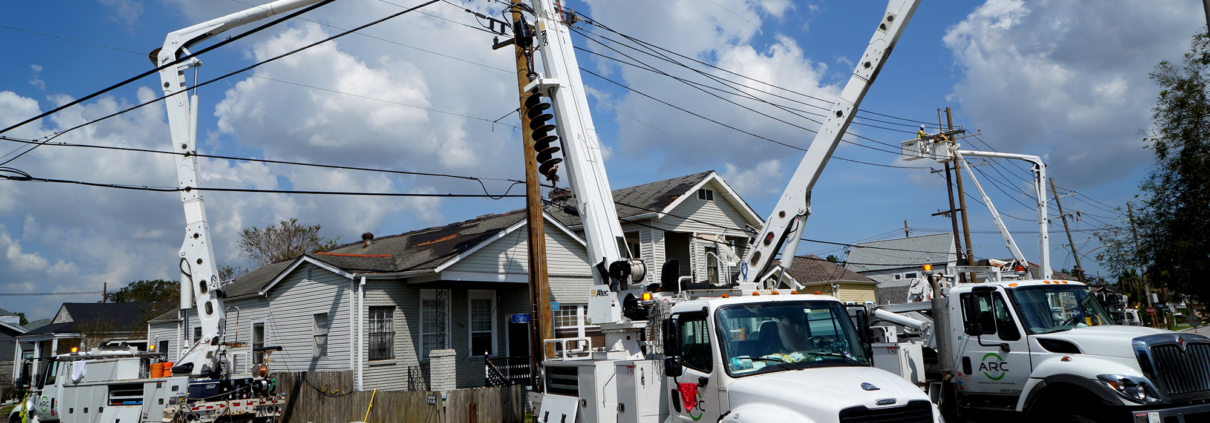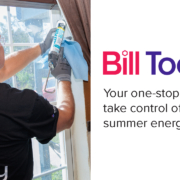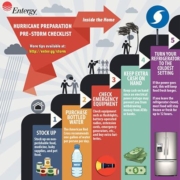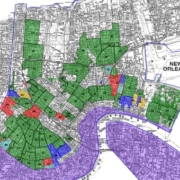More than One Third of Hurricane Ida Outages Restored; Estimates Available for Remainder
In the six days since Hurricane Ida made landfall in Louisiana, Entergy has restored nearly 327,700, or 35%, of the 948,000 customers who lost power due to the storm. Preliminary estimated restoration times are now available for all Louisiana customers here: entergy.com/hurricaneida/etr.
As of 7 a.m. Saturday, there were approximately 470,000 outages remaining in Louisiana (including 150,000 in New Orleans).
Estimated Time of Restoration Details
Damage assessments are nearly completed, with only the bayou region of Louisiana left to be assessed.
Estimates are subject to change as we complete our damage assessments and continue with restoration work in the affected areas.
- Specific estimated restoration times down to the local area, including the coast and areas in the immediate path of the storm, are continuing to be developed and will be released in the coming days. Due to the level of devastation in these areas, some roads remain blocked and access to the damaged areas is difficult. We are using helicopters, drones and other tools to help us assess damage where access is limited.
For our industrial customers, priority is to power critical community services such as fire, police, hospitals and water and communication services. As we restore service to residential, commercial and industrial customers, we must do it in a way that balances the needs of our customers with the ability to support additional load as the system permits.
With a current workforce of more than 24,000 in Louisiana, our dedicated restoration crews are working around the clock to restore power to customers as quickly as is safely possible. We will not stop until the last light is on.
Entergy is providing backup generation and restoring power to several critical-service providers, including hospitals and wastewater facilities. The company also is working individually with large industrial customers, including refineries and manufacturing facilities, to coordinate their restoration.
Damage and Restoration Information
Outage information as of 7 a.m. includes:
|
|
Current Outages |
Previous Outages |
Peak Outages |
Number Restored |
% Restored |
|
Louisiana |
470,000 |
586,000 |
697,000 |
227,000 |
33% |
|
New Orleans |
150,000 |
178,000 |
205,000 |
55,000 |
27% |
Distribution system damage in Louisiana and Mississippi at 9 p.m. Sept. 3 included 22,567 poles, 26,729 spans of wire and 5,261 transformers damaged or destroyed. The number of poles damaged or destroyed is already more than Katrina, Zeta and Delta combined. As restoration continues, these numbers could continue to rise.
Of the 225 affected transmission substations, 141 have returned to service as of 4 p.m., Sept. 3 as well as 112 of 211 affected transmission lines. More than 1,150 miles of transmission lines remain out of service.
We have restored six of the eight major transmission lines that deliver power into the New Orleans area.
‘View Outages’ Map Information
View Outages is a visual representation of the state of the grid. The green and red lines are intended to provide users with indications that line segments are generally either energized or de-energized.
However, as our crews restore power from events like Hurricane Ida it is important to understand that there is a high volume of switching activity that may result in data latencies affecting updates to View Outage Maps.
View Outages maps should not be relied upon for detailed planning purposes. For planning purposes, users should rely upon the location-specific information provided by logging into their myEntergy account.
It’s important to note that while the main line may be energized, the map doesn’t show power flow all the way to the home. There could be damage or other issues between the energized line and the home such as transformers, downed wires from the pole to the home or damage with the meter or within the location itself. The map relies on software to predict the location of outages; actual outages may vary from those predicted.
In some cases, customers will need to get their external electrical equipment repaired before we can safely re-connect service. See THIS SITE to understand what is the customer’s responsibility and what is ours.
Restoration Process
Restoration is a methodical process. While crews are working in all areas, those with the least amount of damage will be restored sooner. Some customers without power may notice that the electric system in their immediate area has been repaired or appears to be in good condition.
Transmission lines that received major damage may need to be fully reconstructed in parts. Once the transmission lines are flowing electricity into the city’s substations, then power can flow through the distribution lines to homes and businesses that are able to accept power.
- We also will reconfigure our electricity delivery system where feasible to return power to some customers more quickly. Once repairs are completed, we will return the system to normal configuration.
- Although the power grid in southeast Louisiana will lack the redundancies that are in place when the transmission system is in full operation, Entergy Louisiana’s engineering and operations teams will follow a plan that will maintain the stability of the system.
General Safety Guidelines
Stay away from downed power lines and flooded areas. Do not walk in standing water and do not venture into areas of debris, since energized and dangerous power lines may not be visible. Be cautions when clearing limbs or downed vegetation as it could hide electrical hazards.
There is no way to know if a downed line is energized or not, so if you see one, keep your distance and call 1-800-9OUTAGE (800-968-8243).
Generator Usage Safety
Some customers without power may choose to use a portable generator, and the safety guidelines should be followed.
- If customers choose to use a generator, they should buy one only from a reputable dealer who can service and maintain the unit.
- Customers should always use portable electric generators in accordance with the manufacturer’s instructions.
- A gasoline engine usually powers stand-alone generators. Customers should use them only in well-ventilated areas. Never use a generator indoors as carbon monoxide from the exhaust is deadly.
- If the generator has panel-mounted electrical receptacles as part of the unit, appliances may be plugged directly into the generator.
- Customers must never connect a generator directly to a building’s wiring without a licensed electrician disconnecting the house wiring from Entergy’s service. Otherwise, it can create a safety hazard for the customer or Entergy’s workers working to restore power. And it may damage the generator or the house wiring.
- Customers should use a licensed electrician to install the necessary equipment should they decide to wire a generator into their home wiring. The equipment should include a switch to transfer the power source between Entergy and the generator.
- The generator should be properly sized for the expected load. For example, a 3-kilowatt generator will produce 3,000 watts. This is enough power for a 1,200-watt hair dryer and a 1,600-watt toaster, with some power left over for a few light bulbs. Customers should plan for additional needs when sizing their generator.
- Customers should consider a generator’s noise pollution as part of their buying decision. The noise may be obtrusive to neighbors without power.
- Commercial customers should consult with an independent engineer or electrician to size the generator, modify wiring and provide for automatic transfer of power during an outage.
- Customers should consult with suppliers, vendors and local electrical utility companies about required permits before starting any work in a home or business.
- Restoration workers who discover a generator attached directly to Entergy’s system will work with the customer to disconnect the generator. As a last resort, the restoration worker will disconnect the customer’s service connection to Entergy, which may take an extended time to reconnect due to the extensive restoration effort underway.









